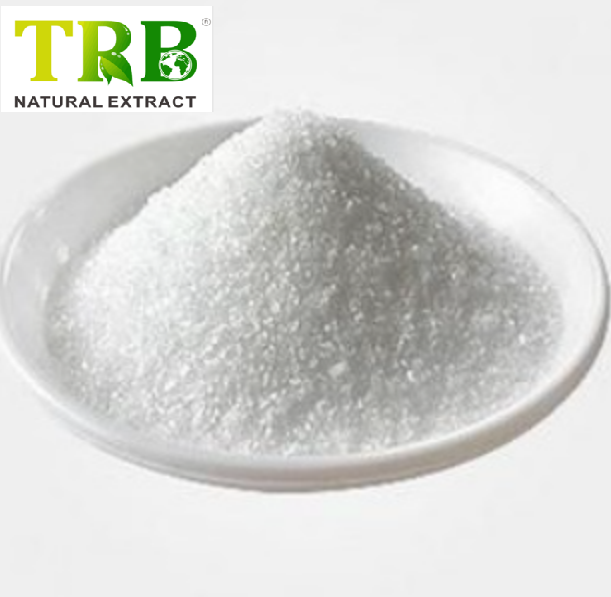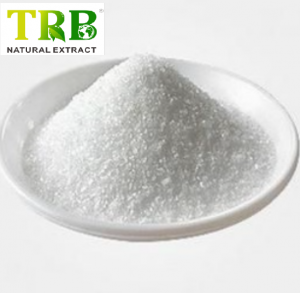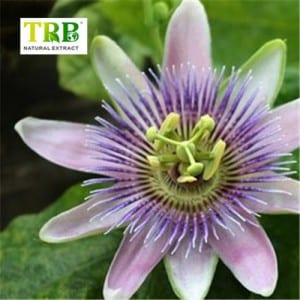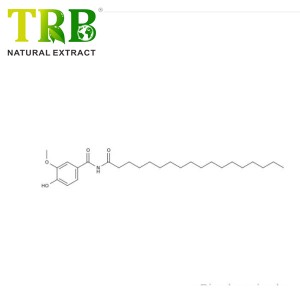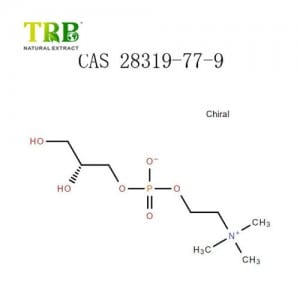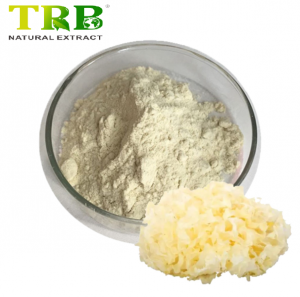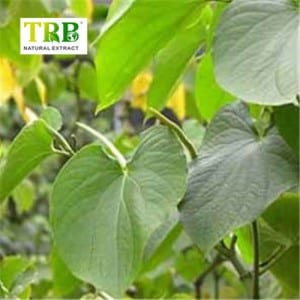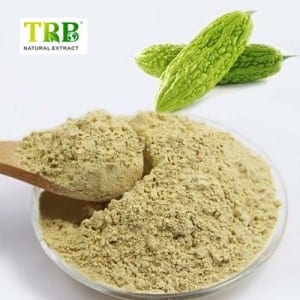Inositol (hexahydroxycyclohexane) is a widely distributed natural constituent of plant and animal tissues. The animal tissues richest in inositol are brain, heart, stomach, kidney, spleen, and liver, where it occurs free or as a component of phospholipids. Among plants, cereals are rich sources of inositol, particularly in the form of polyphosphoric acid esters, called phytic acids. Although there are several possible optically active and inactive isomers, considerations of inositol as a food additive refer specifically to optically inactive cis-1,2,3,5-trans-4,6-cyclohexanehexol, which is preferably designated myo-inositol. Pure inositol is a stable, white, sweet, crystalline compound. The Food Chemicals Codex specifies that it assay not less than 97.0 percent, melt between 224 and 227°, and contain not more than 3 ppm arsenic, 10 ppm lead, 20 ppm heavy metals (as Pb), 60 ppm sulfate, and 50 ppm chloride. Inositol was thought for a time to be a vitamin because experimental animals on a synthetic diet developed clinical signs that were corrected by inositol supplementation. However, no cofactor or catalytic function for inositol has been found; it can be synthesized and occurs in relatively high concentration in animal tissues. These factors argue against its classification as a vitamin. A dietary requirement in man has not been established.
Ingoa Hua: Inositol
Whakapūtātanga: Min 97,0%
Āhuatanga Chemical: karaihe White ranei tioata paura, koreami, me reka; Pātahi kiato: 1.752 (anhydrous), 1.524 (dihydrate), MP 225 ~ 227 ℃ (anhydrous), 218 ° C (dihydrate), wāhi kohua 319 ° C. Rewa i roto i te wai (25 ° C, 14g / 100mr: 60 ° C, 28g / 100mr), paku wairewa i roto i te waihā ewaro, waikawameha ahetiki, ethylene glycol me te nonireka, rewa i roto i Etere, hauwaiwaro me chloroform. Pūmau i roto i te rangi; Kainga ki te wera, waikawa me te alkali, engari he hygroscopic.
CAS No: 87-89-8
Analysis Ihirangi: paunatia tika 200 mg tauira (mua maroke-i 105 ° C mō te 4H), a tuu i te reira ki te ipurau 250mr. Tāpiri 5ml o te ranunga i waenganui i tetahi waikawa pungatara otinga (TS-241) whakamātautau me 50 anhydride ahetiki, a ka hipokina e te karaihe mataaratanga. I muri te para i runga i te pati korohū mō te 20min, whakamatao reira i runga i te pati te huka, tāpiri wai 100mr, me whewhe 20min. I muri i te meangiti, whakawhiti i te tauira ki te 250 mL wehe kōrere te whakamahi i te nui iti o te wai. Ä whakamahi 30, 25, 20, 15, 10 me te 5 mL o chloroform ki te unu i te otinga mō te ono nga wa (tuatahi Heoi, i te ipurau). kohia katoa te kōrero chloroform i roto i te rua o 250m1 kōrere wehe. Horoia te wāhanga whakauru ki 10ml o te wai. Kuhua te otinga chloroform i roto i te wūru miro kōrere ka whakawhiti i te reira ki te pounamu Soxhlet mua-paunatia 150mr. Whakamahia 10ml o chloroform ki horoi te kōrere faataa me te kōrere, ka whakaurua ki roto ki te tangohanga. Whakaeto reira ki te te maroke i runga i te pati korohū, a ka whakawhiti i te reira i roto i te oumu i 105 ° C mō te maroke 1h. Whakamatao i te reira i roto i te desiccator, a paunatia ana e ia. Whakamahia te nui whiwhi o ono inositol tāpia tini i 0,4167, ara te nui hāngai o te inositol (C6H12O6).
taumahi:
1. As food supplements, has a similar effect to vitamin B1. It can be used for infant foods and used in an amount of 210~250mg/kg; Used in drinking in an amount of 25~30mg/kg.
2. Inositol is an indispensible vitamin for lipid metabolism in the body. It can promote the absorption of hypolipidemic medicines and vitamins. Moreover, it can promote the cell growth and fat metabolism in liver and other tissues. It can be used for the adjuvant treatment of fatty liver, high cholesterol. It is widely used in food and feed additives, and is often added to fish, shrimp and livestock feed. The amount is 350-500mg/kg.
3. The product is one kind of the complex vitamin B, which can promote cell metabolism, improve the cell nutrient conditions, and can contribute to development, increase appetite, to recuperate. Moreover, it can prevent the accumulation of fat in the liver, and accelerate the process of removing excess fat in heart. It has a similar lipid-chemotactic action as choline, and therefore useful in the treatment of hepatic fatty excessive disease and cirrhosis of the liver disease. According to the “food fortifier use of health standards (1993)” (Issued by the Ministry of Health of China), it can be used for infant food and fortified beverages at an amount of 380-790mg/kg. It is a vitamin class medicines and lipid-lowering drug which promote the fat metabolism of liver and other tissues, and be useful for the adjuvant treatment of fatty liver and high cholesterol. It is widely used in additives of food and beverage.
4. Inositol is widely used in pharmaceutical, chemical, food, etc. It has a good effect on treating diseases such as liver cirrhosis. It can also used for advanced cosmetic raw materials, with high economic value.
5. It can be used as a biochemical reagent and also for the pharmaceutical and organic synthesis; It can lower the level cholesterol and have sedative effect.
|
Ētahi atu mōhiohio o TRB |
||
| R tohu egulation | ||
| USFDA, CEP, Halal kosher GMP ISO Tiwhikete | ||
| Kounga pono | ||
| Fatata 20 tau, kaweake 40 whenua me rohe, neke atu i te 2000 wā whakaputaina e TRB kahore tetahi raruraru kounga, tukanga purenga ahurei, poke me te mana te viivii tika USP, EP me CP | ||
| Pūnaha Kounga whānui | ||
|
|
▲ Kounga Pūnaha Tātari |
√ |
| ▲ mana Tuhinga |
√ |
|
| ▲ Pūnaha Whakamana |
√ |
|
| ▲ Pūnaha Whakangungu |
√ |
|
| Kawa Tātari ā-▲ |
√ |
|
| ▲ Pūnaha Tātari Suppler |
√ |
|
| ▲ Taputapu Facilities Pūnaha |
√ |
|
| ▲ Pūnaha Mana Material |
√ |
|
| ▲ Pūnaha Mana Production |
√ |
|
| ▲ Pūnaha Tapanga Packaging |
√ |
|
| ▲ Pūnaha Mana Laboratory |
√ |
|
| ▲ manatokonga Pūnaha Whakamana |
√ |
|
| ▲ Regulatory Pūnaha Affairs |
√ |
|
| Mana Whole Rauemi me tukanga | ||
| Tino mana katoa rauemi raw, oko, me te materials.Preferred tākai raw rauemi me oko, me ngā rauemi tākai kaiwhakarato ki US DMF number.Several kaituku rauemi raw rite te haapapûraa supply. | ||
| Kaha Institutions Cooperative ki te tautoko i | ||
| Institute o te huaota / MoE o koiora / Academy o Pūtaiao me te Hangarau / University | ||
